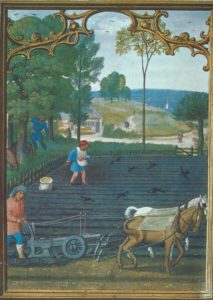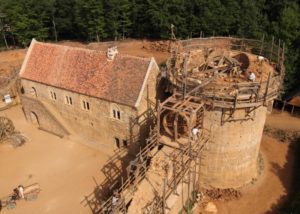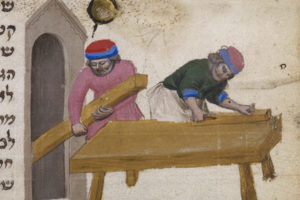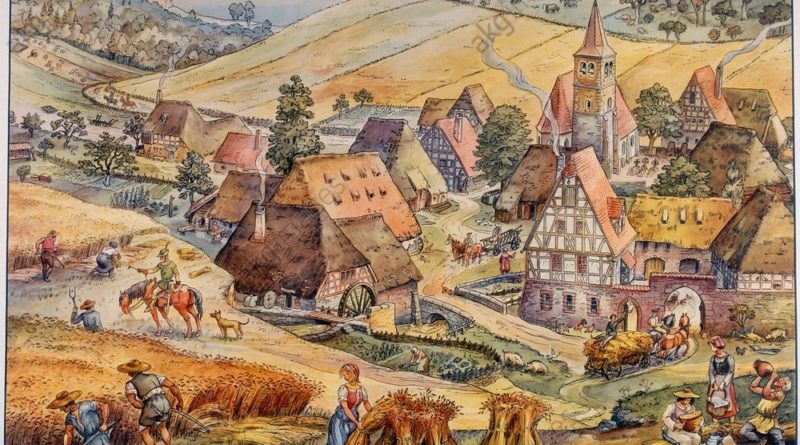Incorporating Mundane Life into Your Fantasy/Middle Ages Game: Farming, Construction & Logging
The mundane reality of life is something often overlooked when GMs are talking about the world in which their fantasy or Middle Ages game. You describe the market, sure. The tavern and perhaps the grand library, but too often, what the common folk are up to just gets completely left behind. Today, I wanted to talk about what kinds of things you might describe to your players to give the land more flavor.
Farming
 Players spend a lot of time travelling between cities in a lot of games. When I ran my Tiamat campaign, there’s a good portion of that adventure that’s just travel.
Players spend a lot of time travelling between cities in a lot of games. When I ran my Tiamat campaign, there’s a good portion of that adventure that’s just travel.
What I didn’t do is show a lot of farming. All along the Sword Coast, there’s a ton of farms and arable land. You’d need it to feed the millions who live in Baldur’s Gate, Neverwinter, and Waterdeep, not even including the dozens of smaller towns and villages throughout. As you travel through these regions, you should see long plots of wheat and corn fields. Large open patches of dirt with green tufts sticking up implying a healthy harvest.
Mind you, without modern farming equipment, you wouldn’t have a single farmer out there tilling their fields. You’d have farmhands working the land. Tilling up the earth in early spring with plows pulled by oxen or ponies before sowing seeds. When sowing, you’d have groups of farmhands walking slowly in the fields, throwing seeds out into the soft earth. In summer, you’ll have farmhands walking through the fields, checking for blight, and removing sick or unproductive stalks. By late summer and early fall, they would begin the harvest, with dozens of people in each field with scythes cutting down the tall grain, or bending down in the fields to pull up carrots and radishes.
Perhaps the farmhands stop their work and wipe their brow as the heroes pass, wondering what adventures you’re heading off to. Perhaps they see the work of adventurers as lazy and look on you with disdain. Whatever the result, doing so will draw your players’ attention to those who grow the food they eat.
Construction

Things were ALWAYS getting built in the Middle Ages. While items were built to last, there was always some building that needed to be torn down and rebuilt, or a new castle or church under construction. The wood palisades are being replaced with strong stone walls, or the village is digging a new well.
Construction in the Middle Ages looked much like it does today, with extensive scaffolding, and cranes powered by large wheels that they would place (often blind) workers into to slowly raise lumber or stonework to the higher levels. Work would go from sunup to sundown, day in and day out.
For smaller constructions without the funding of a larger organization such as the nobility or the church, houses or barns would be put up by the community, coming together to help move stone and tree to expand the village. Groups of farmers would break from tending the fields to gather together with picks and shovels to dig a new well, while children would bring the heaviest rocks they could carry to help build the well’s walls. There should always be construction going on around your towns. No cities were ever complete, even if they were fully enclosed by walls.
Road construction was also a huge part of the world, just as it is today. With all kinds of fantastical creatures about, whole roads may need to be reconstructed. A Bulette infestation could lead to whole sections of roads obliterated. A dragon’s fire breath could melt the stones of the road, fusing them together and making it uneven.
You can see in the Youtube video below how precise Roman roads were here, and how they would be constructed. Incorporating some half-completed roads with work crews into them could really add some flavor.
Logging
 Forests in the Middle Ages were very well cared for, with workers ensuring the forest floors were clear to make for easier hunting, and making it easier to get to the wood they needed to cut down.
Forests in the Middle Ages were very well cared for, with workers ensuring the forest floors were clear to make for easier hunting, and making it easier to get to the wood they needed to cut down.
There were also many organized copses, with trees planted in straight rows to make for both easier harvesting as well as easier management while they grew. Some trees would be coppiced to create smaller, straight branches for arrows and bows.
Below, you can see an example of Medieval timber work you could see villagers performing as the heroes made their way across the land.
Next time, we’re gonna take a look at religious festivals, tanning, shearing, and shoeing in the Middle Ages as well.
Support Dice Monkey with a single payment on Ko-Fi, or become a Dice Monkey Patron. Thank you for your support!

